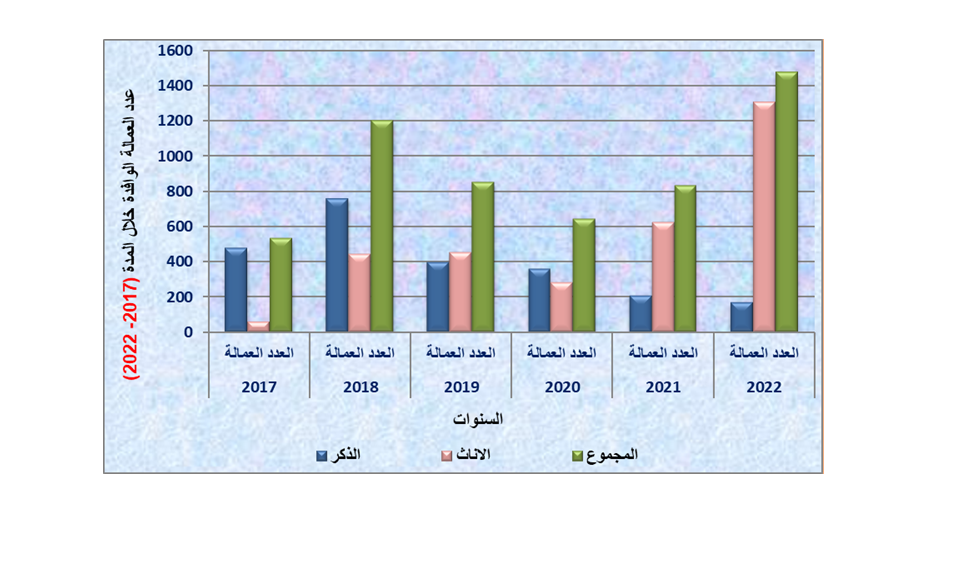An Economic Analytical Study of The Reality of Expatriate Workers for The Period (2017 - 2022) (Dohuk Governorate as An Example)
DOI:
https://doi.org/10.21271/zjhs.28.2.6Keywords:
expatriate workers, Kurdistan Region, money transfers, unemployment rates, Dohuk Governorate.Abstract
This research aims to analyze the reality of expatriate workers in Dohuk Governorate for the period (2017 - 2022), and data was obtained from the Directorate of Labor and Social Security in the governorate. To achieve the research goal, we used the descriptive analysis approach with regard to the demographic, economic and social characteristics of expatriate workers, and it became clear to us that the private sector in the region prefers expatriate workers due to their lower wages compared to the wages of local workers. One of the most important results we reached is that in 2022, the percentage of expatriate workers reached 27% due to the improvement in the economic and health situation. In 2020, the lowest employment rate reached 11% due to the repercussions of the Corona virus. The demand for female labor increased in 2022, reaching 89% compared to males, 11% for the same year. As for the age groups of expatriate workers, the highest percentage was recorded in the group (30-35) years, reaching 28%, while the lowest percentage was recorded in the age group (54-59). year and amounted to 5%. As for expatriate workers, according to the most important sending countries, Turkey ranked first and recorded the highest percentage in 2017 and reached 43%. In 2022, Ghana recorded the highest percentage and reached 24% compared to other countries. As for financial remittances to expatriate workers, they amounted to $400,550 in the year 2022, according to World Bank reports showing high unemployment rates in sending countries. Georgia had the highest unemployment rates, at 11.3%, followed by Nepal, Iran, and Turkey, at 11.1%, 11%. 10%, respectively. Unemployment rates in the region reached (16.5), the highest unemployment rates in Dohuk Governorate reached (24.1) (Kurdistan Region Statistics Authority). One of the most important proposals is the regional government’s attempt to address the problem of unemployment in Dohuk Governorate and the necessity of replacing expatriate workers with local workers.
References
اولاً: الوثائق الرسمية:
- World Bank national accounts data, and OECO National Accounts data files.
- وزارة العمل والشؤون الاجتماعية، مديرية العمل في محافظة دهوك، (شعبة أجانب).
- تقرير البنك الدولي لعام 2022.
- هيئة إحصاء إقليم كوردستان
- صندوق النقد العربي، 2021، مفاهيم اقتصادية اساسية الناتج المحلي الاجمالي، دولة الامارات العربية المتحدة.
ثانياً: الرسائل الجامعية:
- خالد بن محمد سالم الغيلاني، 2014، الاثار الاجتماعية والاقتصادية للعمالة الوافدة على المجتمع العماني (دراسة ميدانية)، رسالة ماجستير، سلطنة عمان.
- الروحاني عبدالحليم سالم ، 2015 ، تأثير العمالة الوافدة على تزايد معدلات الجريمة في المجتمع العماني ، رسالة ماجستير ، الأردن ، جامعة مؤتة .
- حيدر عبدالامير جاسم ، 2015، العمالة الوافدة في سوق العمل لبلدان مختارة مع إشارة خاصة للعراق ( المنافع والتكاليف ) ، رسالة ماجستير ، كلية الإدارة والاقتصاد ، جامعة المستنصرية .
- سعبد محمد سعيد محمد برمان ،2021 ، اثر العمالة الوافدة السلبي على المجتمع القطري ،رسالة ماجستير ،جامعة حمد بن خليفة ، القطر .
- نعيم بن جزاء الطويرش، 2010 ، العمالة الوافدة وعلاقتها بالجريمة من حيث أسبابها وانواعها في المجتمع السعودي ( دراسة ميدانية في السجن العام بمدينة جدة ، رسالة ماجستير ،جامعه مؤته ، الأردن .
ثالثاً: المجلات العلمية
-زيمان عبدالقادر مجيد عظيم، 2014، واقع العمالة الوافدة النسوية في الاسرة الكوردية (دراسة ميدانية) في مدينة السليمانية، جامعة السليمانية، مجلة العلوم الاجتماعية، العدد 6، السنة السادسة.
-سونيا آرزوني وارتان، 2023، العمالة الوافدة وتكاليفها الاقتصادية في العراق، مجلة اقتصاديات شمال افريقيا، المجلد 19، العدد 31.
- د. ستار جبار الركابي، 2022، العمالة الوافدة إلى دولة الكويت اسبابها ونتائجها واثارها، مجلة كلية تربية، جامعة الواسط، العدد (49)، المجلد (3).
- طارق عبدالعزيز الدوب، عبدالله جاسم زكريا، 2021، تأثيرات جائحة كوفيد - 19 على أوضاع العمالة الوافدة وجهود دولة الكويت في التعامل معها (دراسة مقارنة بين اتجاهات المواطنين والوافدين)، المجلة العالمية للاقتصاد والاعمال، المجلد 10، العدد 1.
- عمر رزاق حمود، 2022، العمالة الوافدة وأثارها في الاقتصاد السعودي 1960 – 1990، مجلة كلية التربية، جامعة واسط، مجلد 2، العدد 47.
- منتصر إبراهيم عبدالغني وآخرون، 2021، (تجزئة سوق العمل بين العمالة الوافدة في المحافظات العمانية)، المجلد 12، العدد 2، جامعة السلطان قابوس، عمان.
- د. بسمة رحمن عودة الصباح، 2017، (العمالة الوافدة في العراق – الاسباب والآثار)، مجلة جامعة القادسية، العدد 8.
- د. جمال عزيز فرحان، حيدر عبدالامير جاسم، 2018، (واضع العمالة الوافدة في العراق بعد عام 2003 لعينة عشوائية (باستخدام التحليل العاملي)، مجلة المستنصرية للدراسات العربية والدولية، العدد 5،
رابعاً: الكتب:
- عادل لطفي، 2007، مؤشرات سوق العمل، سلطنة عمان.
- د. محمد ابراهيم مقداد، مازن أبو حصيرة (2018)، اقتصاديات العمل، كلية التجارة الجامعة الاسلامية بغزة.
- د. مدحت القريشي ، 2007 ، اقتصاديات العمل ، ط1 ، جامعة البلقاء التطبقية ، الأردن، دار وائل للنشر .

Downloads
Published
Issue
Section
License
Copyright (c) 2024 Khamy Nasir Rusheed

This work is licensed under a Creative Commons Attribution 4.0 International License.









